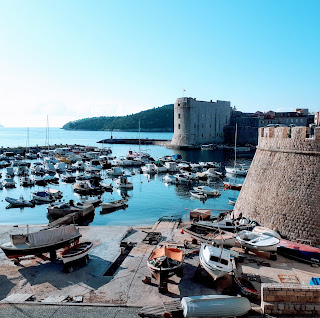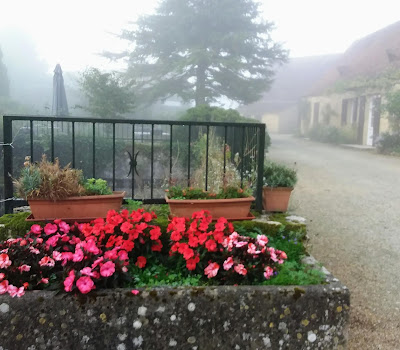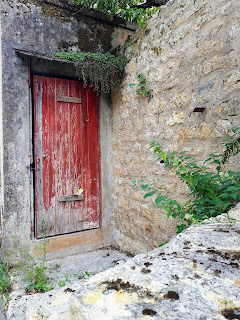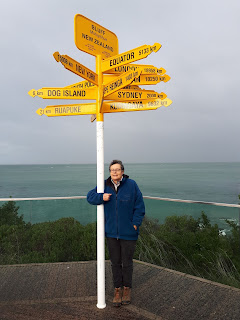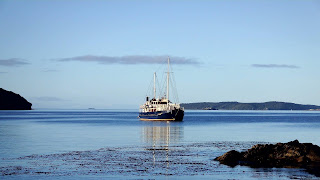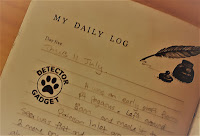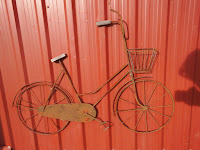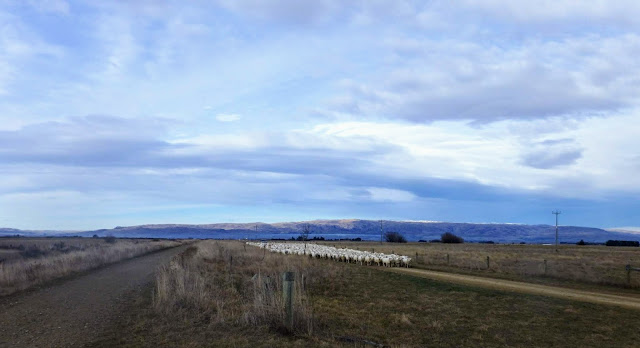How to best describe our week in China? An incongruous metaphor, I know, but I feel as though I’ve been dipped into a vat of wondrous experiences and then hauled out, dripping wet but seasoned with exotic new flavours. And I'm not just talking about the food.
 |
| Our first day on the Wall, with fellow trekkers |
It was a giant leap into the unknown when we landed at Beijing airport late at night. The arrangement with the tour company was that we would be met by a driver who would then deliver us to the rest of the Great Wall trekkers.
The airport proved to be the first challenge. Let's just say there was no welcoming vibe in the cavernous arrivals hall. We walked. We queued. We pressed thumbprints onto a screen. We queued. We handed over our passports with necessary visas. We pressed our thumbs again and, this time, various other digits onto a screen. We waited and waited for a train then shuffled to the luggage carousel and through customs.
The excitement of emerging onto the public concourse and scanning faces to find our names on a board was tempered by the fact that it was now well after midnight, not at all a sensible time to be embarking on an adventure in the Middle Kingdom.
Sun, our driver, was inordinately chatty for the time of night. In return, we could only offer a drowsy wakefulness as the kilometers ticked over. With the rest of China sensibly asleep, Sun had the roads to himself and made the most of the 120 km/hour speed limit.
 |
| A Great Wall 'restaurant', with elderly dog. We were always the only guests at our evening meals |
We met the four other trekkers at breakfast in the guesthouse the next morning. Having joined the tour late (our original challenge trek had been cancelled), we were happy to be amongst congenial Aussie company. That first breakfast became the pattern for the remainder of the week. It was plentiful and fresh, it involved rice and vegetables and jasmine tea and it required chopsticks. No matter where we ate, and how impoverished the surroundings, the food was always delicious.
Our first day of trekking saw us climb innumerable steps to reach the top of the wall at Gubeikou. On this quiet, unrestored part of the Wall there were few other walkers so we made good progress, despite regular photo stops. It was a day of wild beauty, open skies and breathtaking vistas of the Wall snaking across the ridges behind and in front of us.
 |
| Lunch on the first day was served in an ancient tower |
 |
| We shared the Wall with many, many Chinese in festive mood |
So it was with a sense of great achievement that we finished our trek on day four with a steep climb from our campsite in the valley up to Wang Jing tower at the summit of Mt Simatai.
Here, we found ourselves the only foreigners amongst a cascade of Chinese day trekkers who streamed onto the summit from a ruinous section of the Great Wall, officially closed to the public. They were just as excited as us about reaching the tower, not surprisingly given that they'd disobeyed a number of signs prohibiting climbing that route, and were keen to record the experience with the nearest Westerner. A frenzy of picture-taking ensued.
It was hard not to admire these agile young things who could nimbly climb great heights along broken walls then promptly light a cigarette to celebrate.
Respect, though, to the slightly older chap who managed to negotiate a long stretch of the prohibited section of wall with a cigarette in his mouth the WHOLE way. He was using both hands to stay alive, of course, so where else could he park it? (Away from Australia and New Zealand, smoking in public is at epidemic levels, even amongst the young and fit. In Croatia, our mountain bike guide Marko would regularly disappear for a quiet smoke. His colleague, a super-intelligent history teacher who moonlighted as a bike tour guide, could be seen on deck at night having a surreptitious vape. In French cafés, we were generally driven indoors in the summer heat because the outdoors was owned by smokers.)
 |
| With my imperial guardian lioness at the end of our Great Wall trek |
Our return to Beijing had the advantage of daylight this time but the obvious disadvantage of congested roads. It was late afternoon before we reached the Dong Fang hotel, home for the next few days.
The Dong Fang opened in 1918, and has had a long association with China's political leaders. It was at the Dong Fang, for instance, that a group of scholars gathered to develop pinyin, the system of converting Chinese characters into the Latin alphabet. Or so they claim. Wikipedia research suggests a longer timeline and a broader range of personnel were involved. But why spoil a good story? I can safely say, though, that the hotel's décor has barely changed in its 101-year history. After two nights in tents in the shadow of the Wall, Suzanne and I were very happy to indulge in its period charm. The shower was especially popular.
Beijing was a blur of temples, palaces and vast open spaces. With our guide, we navigated the crowds to explore the Forbidden Palace and Tiananmen Square. With fellow trekkers Cathy and Steve, we enjoyed the delightful Summer Palace, the Emperor's wee bach on the outskirts of the city. On our own, Suzanne and I used the modern metro system to broaden our shopping parameters.
Walking the length of Tiananmen Square, we observed thousands of people (for once, I'm not indulging in hyperbole) dutifully queuing in the heat to shuffle past Mao's tomb. It was too easy to recall the events of April 1989 when mass resistance resulted in a massacre, and the image that conveyed the story to the rest of the world. But that's China: a country of complexities.
 |
| Tiananmen Square |
China has been good for us. This adventure was never going to be easy travelling. But Suzanne and I signed up for the Great Wall trek in order to be challenged. We signed up, too, because we both wanted to support the work of the Mental Health Foundation. Our fundraising challenge was to Conquer the Wall. And thanks to so many of you now reading this blog, we did just that.











